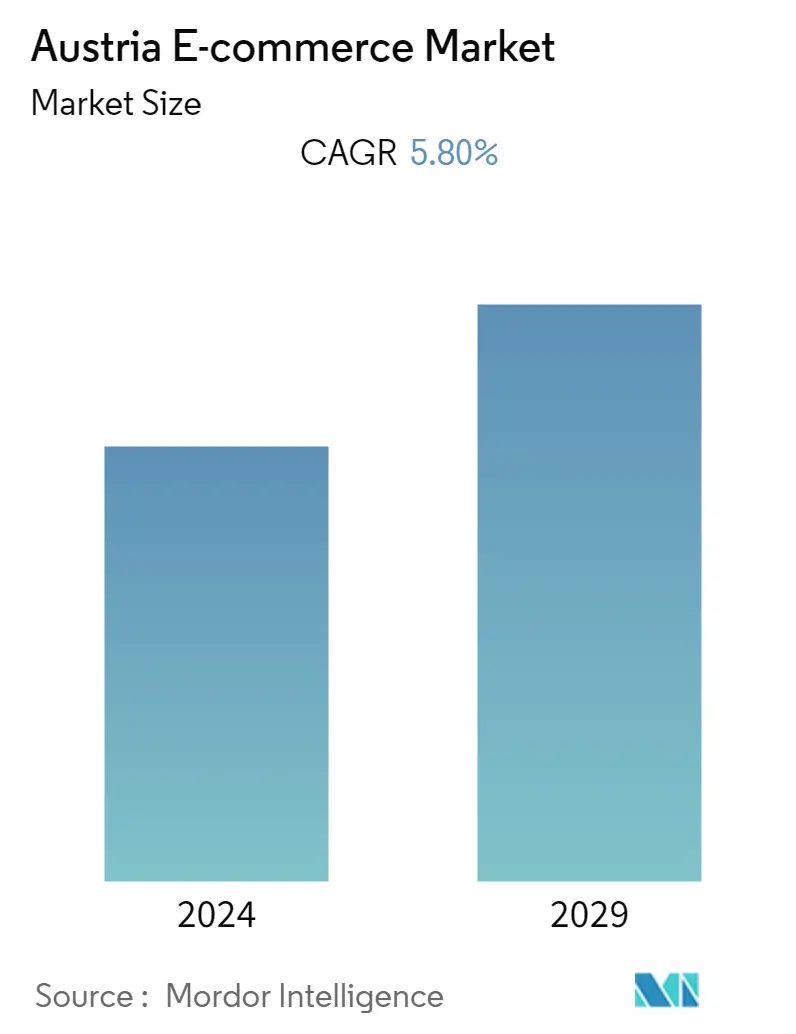Market Size of Austria E-commerce Industry

| Study Period | 2019 - 2029 |
| Base Year For Estimation | 2023 |
| Forecast Data Period | 2024 - 2029 |
| Historical Data Period | 2019 - 2022 |
| CAGR | 5.80 % |
| Market Concentration | Medium |
Major Players
*Disclaimer: Major Players sorted in no particular order |
Austria E-commerce Market Analysis
E-commerce (electronic commerce) refers to the selling and buying of products and services by transferring funds or information over an electronic network, mainly through the internet. The European e-commerce market has registered strong escalation over the last few years, offering exciting opportunities for online retailers across diverse sectors. Austria is one of Europe's major consumer markets and an important e-commerce market. The primary selling medium for distance selling in Austria is increased online shopping, including smartphone shopping.
- The rapidly increasing urbanization and digitalization are the key factors driving the growth of the e-commerce market in Austria. The increased penetration of internet services and electronic devices like smartphones, tablets, and laptops has boosted the e-commerce market.
- As a part of e-commerce growth in Austria, the government came up with new policies in 2021. For instance, In July 2021, VAT e-commerce packaging was introduced in the country. Similarly, The national transposition of the Omnibus-directive (New Deal for Consumers) and the directive on certain aspects concerning contracts for the availability of digital content and digital services and on certain aspects concerning contracts for the sale of goods, and significant upcoming e-commerce regulations at EU-level: DSA/DMA were also introduced.
- According to Eurostat, from a survey before 2021, 90% of people aged between 16 to 74 in the European Union used the internet, of which 74% had ordered or purchased goods and services for personal use. Online shopping surged by one percentage point compared with the year 2020.
- According to the European e-commerce Report 2021, a significant increase in e-shoppers can be seen in 2020 due to the government restrictions imposed during the Covid-19 pandemic, which compelled customers to shop online. Austria recorded 74% e-shoppers in the same year.
Austria E-commerce Industry Segmentation
B2 B E-commerce and B2C E-commerce segment the Austria e-commerce market. By B2C E-commerce, the market studied is further subdivided into beauty & personal care, consumer electronics, fashion & apparel, food & beverage, and furniture & home. The report studies the impact of covid-19 on the studied market.
Austria E-commerce Market Size Summary
The Austrian e-commerce market is experiencing significant growth, driven by increased urbanization and digitalization. The proliferation of internet services and electronic devices such as smartphones, tablets, and laptops has facilitated this expansion. The government's introduction of new policies and regulations, including VAT e-commerce packaging and the national transposition of the Omnibus-directive, has further supported the market's development. The Covid-19 pandemic acted as a catalyst, pushing more consumers towards online shopping, which has become a prevalent trend. The market is characterized by a high level of cross-border shopping, with Austrians frequently purchasing from international retailers, particularly from Germany, Italy, and Switzerland.
The competitive landscape of the Austrian e-commerce market is dominated by major players like Amazon, Zalando, and MediaMarkt, who are continually innovating to enhance their market presence. The fashion industry, in particular, has seen a surge in online retailing, with platforms like Zalando and H&M expanding their offerings to include sustainable and diverse brands. The market is also witnessing strategic partnerships and acquisitions, such as Shop Apotheke's acquisition of FIRST A, which aim to strengthen positions in emerging sectors like quick commerce. Payment innovations, such as Klarna's "Pay Later 30" option, are further enhancing the consumer shopping experience, making online purchasing more flexible and appealing.
Austria E-commerce Market Size - Table of Contents
-
1. MARKET INSIGHTS
-
1.1 Market Overview
-
1.2 Industry Attractiveness-Porter's Five Forces Analysis
-
1.2.1 Bargaining Power of Suppliers
-
1.2.2 Bargaining Power of Buyers/Consumers
-
1.2.3 Threat of New Entrants
-
1.2.4 Threat of Substitute Products
-
1.2.5 Intensity of Competitive Rivalry
-
-
1.3 Key market trends and share of e-commerce of total Retail sector
-
1.4 Impact of COVID-19 on the e-commerce sales
-
-
2. Market Segmentation
Austria E-commerce Market Size FAQs
What is the current Austria E-commerce Market size?
The Austria E-commerce Market is projected to register a CAGR of 5.80% during the forecast period (2024-2029)
Who are the key players in Austria E-commerce Market?
Amazon, Zalando, MediaMarkt, Universal and H&M are the major companies operating in the Austria E-commerce Market.

